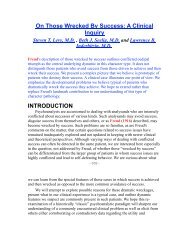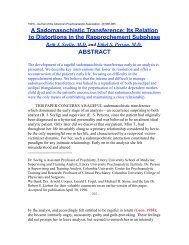The Rape of Medusa - Beth J. Seelig, MD
The Rape of Medusa - Beth J. Seelig, MD
The Rape of Medusa - Beth J. Seelig, MD
Create successful ePaper yourself
Turn your PDF publications into a flip-book with our unique Google optimized e-Paper software.
her advice. Perseus and the subsequent knights wearing the image <strong>of</strong> <strong>Medusa</strong> on<br />
their shields have not suffered the girl's more intense conflict over separation from<br />
and competition with the powerful maternal image. Perseus has no need to<br />
challenge Athena. He can accept her guidance and protection as gifts from the<br />
good mother. However, Arachne claims her ability to weave as her own, refusing<br />
to accept subordination to the goddess-mother. This is the quandary the little girl<br />
finds herself in as she struggles to separate from, while identifying with, her<br />
mother. To accept maternal authority and superiority during this process can<br />
threaten the development <strong>of</strong> a coherent identity that is independent <strong>of</strong> Mother.<br />
Athena is like many excessively narcissistic mothers who cannot accept their<br />
daughters’ independence. She employs a potion made by the witch Hecate to<br />
vengefully turn Arachne into a spider when the girl insists on continuing to<br />
compete with her in the art <strong>of</strong> weaving. As in the <strong>Medusa</strong> myth, the ‘bad mother’<br />
aspect <strong>of</strong> Athena is split <strong>of</strong>f and projected on to another female figure, the witch.<br />
Athena only uses the destructive potion (bad poisonous milk from the witchmother).<br />
<strong>The</strong> ability to make it belongs to a completely separate hated and feared<br />
image <strong>of</strong> the mother. This allows the image <strong>of</strong> Athena to remain benign, despite<br />
her malignant competitive action.<br />
<strong>Medusa</strong> has been widely regarded as representing the negative aspects <strong>of</strong> the<br />
mother. Miller (1958) suggested that the hideous face <strong>of</strong> <strong>Medusa</strong> can represent<br />
projection on to the mother <strong>of</strong> the daughter's ugly, evil and hostile impulses, an<br />
expression <strong>of</strong> competitive wishes. More recently, Herman stated,<br />
Must every Kore not stand in relentless opposition to this entangling<br />
aspect <strong>of</strong> the mother who would wind her coils about her and never let<br />
her go? And indeed, it was Athene who, when the <strong>Medusa</strong> defiles her<br />
temple with her lecherous seductions, changed the hair <strong>of</strong> the <strong>of</strong>fender<br />
into coiling snakes and serpents, as a just punishment for her vile habits<br />
<strong>of</strong> the swamp (1999, p. 55).<br />
She goes on to tell us that when Demeter was looking for her abducted<br />
daughter in the guise <strong>of</strong> an old woman, she wore the mantle <strong>of</strong> <strong>Medusa</strong> and was<br />
described as ‘the Black One’,<br />
- 904 -<br />
Demeter Erynis. In this reading <strong>of</strong> the myth, the equation <strong>of</strong> <strong>Medusa</strong> with the<br />
bad mother is very clear. In contrast, duBois states, ‘<strong>The</strong> myth <strong>of</strong> <strong>Medusa</strong>, is a<br />
myth <strong>of</strong> fear <strong>of</strong> women, fear <strong>of</strong> their archaism, their self-sufficiency, their buried<br />
power’ (1988, p. 92).<br />
<strong>The</strong> worship <strong>of</strong> Athena goes hand in hand with a fear and devaluation <strong>of</strong> the<br />
sexual and powerful woman represented by <strong>Medusa</strong>. Persephone is saved from the<br />
devaluation because she is regarded as being the victim <strong>of</strong> male lust. <strong>Medusa</strong> is not




